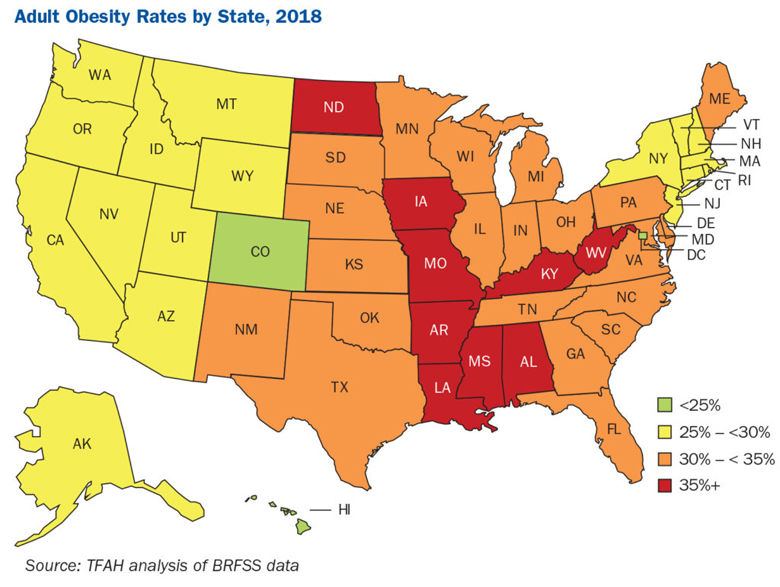
While obesity rates in D.C., Maryland and Virginia aren’t as bad as they are in some other states, they’re worse than they used to be. And that’s the case for every other state around the country.
The new report published Thursday by the nonprofit, nonpartisan Trust For America’s Health finds nearly 31% of Americans — or more than 100 million people — are obese, with the obesity rates in some states spiking significantly in recent years.
Nearly 31% of the residents in Maryland (30.9%) and just over 30% of Virginia residents (30.4%) are considered obese — roughly in line with the national average. The obesity rate in D.C. is just under 25%, which “sounds good compared to the rest of country, but it’s much higher than it used to be,” said John Auerbach, the president and CEO of Trust For America’s Health.
Nationwide, D.C., which was part of the state-by-state comparison, ranked 50th out of 51. Maryland tied for 25th with Pennsylvania, and Virginia tied with Maine for 28th.
“If we look just a few years ago the percentages were significantly lower” in D.C., Maryland, and Virginia, said Auerbach.
The latest numbers from 2015-2016 show that nine states have obesity rates of at least 35% and two more check in at 34.8%. West Virginia has with an obesity rate of 39.5% and it’s tied with Mississippi for the highest obesity rate in the country. In 2012 there wasn’t a single state with a rate as high as 35%.
Noticeable racial and economic disparities are seen in the report, which is based on data from 2015-16 and was the most recently available information. It finds that nationwide, nearly half of all blacks and Latino adults are obese. That compares to an obesity rate among whites of 37.9% and 12.7% among Asians. Higher poverty rates also tend to correlate with higher obesity rates too.

“The nation is getting fatter,” said Auerbach. “The main concern there … is the medical implications of that. Because we know when someone has obesity they are at significantly higher risk for a wide variety of health issues: diabetes, hypertension, heart disease, as well as an impact on their knees and their hip. We are quite concerned that this level of obesity will result in what is in fact preventable illnesses, injuries and death.”
What are the solutions?
Being smarter about diets and exercise are the best ways to lose weight individually.
But Auerbach said there are steps the local governments can take to help push people in the right direction, based on the results of two unrelated studies released earlier this year.
“One looked at the Women, Infants, and Children or WIC program,” which is part of the Supplemental Nutrition Program, said Auerbach. “It showed that program was an effective program for reducing childhood obesity.”
“There also are a number of studies this year that demonstrated that the relatively new approach of taxing sugar-sweetened beverages was an effective approach at reducing the consumption of soda, which is a major factor in terms of contributing to obesity.”
Auerbach said expanding the WIC program and taxing sugary drinks at a broader level could have a bigger impact. But he also said that making neighborhoods more walkable and bikeable can have a positive impact.
Top 10 states with highest obesity rates
(Tied) Mississippi and West Virginia — 39.5%
3. Arkansas — 37.1%
4. Louisiana — 36.8%
5. Kentucky — 36.6%
6. Alabama — 36.2%
7. Iowa — 35.3%
8. North Dakota — 35.1%
9. Missouri — 35%
(Tied) Oklahoma and Texas — 34.8%







